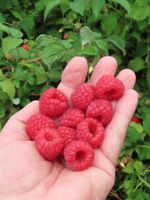Mon-Fri 9am - 5pm Mountain time
Red Mammoth Raspberry vs Grouseberry
Rubus sp. SK Red Mammoth
Vaccinium scoparium
SOLD OUT
CUSTOM GROW
Developed by the University of Saskatchewan Fruit Program, SK. Red Mammoth was a high yielding and firm variety released in 1999. It produces distinctively large bright red berries about 1 inch wide. It is also more cold hardy than older raspberry cultivars. Red Mammoth is firm which makes it suitable for commercial production and sweeter than Boyne. Floricane.
Needs to be trellised as canes are not as sturdy as other varieties.
Grouseberry is a native, low-growing deciduous shrub known for its edible red berries. In early summer, it produces small, urn-shaped flowers ranging from white to pink that attract bees and other pollinators. The berries provide an important food source for many types of wildlife, including game birds such as grouse, which gives the plant its common name. People can also enjoy the berries fresh or in baked goods, though they can be difficult to harvest in large quantities.
Spreading by rhizomes, Grouseberry forms dense, broom-like mats that help stabilize soil and prevent erosion, while also providing cover for ground-nesting wildlife. It is commonly found beneath conifers in open forests, subalpine meadows, and occasionally on rocky slopes in mountainous regions. It is well-suited for naturalization, ecological restoration, and soil stabilization projects.

